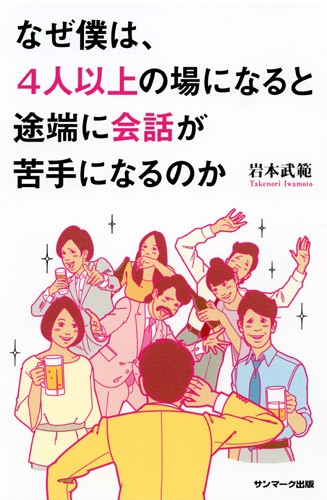


ISBN978-4-7631-3626-8 C0030
205 pages / May 2017 / 1,100 yen (w/o tax)
Why are you able to converse one-on-one but not in a group of four or more?
☆ This book will help you communicate better in a large group.
☆ This is the literary debut of Takenori Iwamoto, who analyzed over 300 billion human behavioral patterns at Kyoto University.
☆ Why we feel “the more people, the less merry,” and how we can deal with it.
☆ Learn why one-on-one conversations are easier than group conversations.
☆ Learn how to be more conversational in a group of four or more.
☆ Be comfortable around social partiers!
※ This book is for those who have a hard time socializing in large groups.
“I can talk one-on-one, but I become shy in large groups.”
“When at parties, all I want to do is go home.”
Does this describe you? Do you feel you’re the only one not talking? Are you the only one not having fun? Do you worry people assume you’re gloomy and don’t have any friends?
This book explores ways to break away from shyness in large groups, and introduces the “group of 4” hypothesis.
Here you’ll find the results of over 1,000 group interviews and studies of over 300 billion behavioral patterns to explain with scientific backing how to become sociable in groups of four or more.
◎ We now know the reason why talking in a group is difficult.
◎ Feel at ease at parties and in shared taxis.
◎ Learn why you find chat groups of more than four people annoying.
◎ Learn how to overcome struggles with one-on-one interaction.
◎ Which seat attracts the most conversation?
◎ Learn which colors make people want to avoid you.
◎ Learn a scientific method that gets your words flowing.
◎ Don’t talk about the weather! We have the best topics for large groups.
◎ Leave a good impression by standing a certain distance from people.
◎ Learn a secret technique for overcoming “group of four” anxiety.
◇ Preface The gap between 3 and 4
・ Sales decrease when three lines are made into four.
・ Being chatty doesn’t make chatting easier.
◇ Chapter 1 Why conversing one-on-one is easier than in groups of four or more
・With more people come more anxiety types
・Once people become silent, it’s harder to speak up again.
◇ Chapter 2 Why is the conversation always focused on that one person?
・Do people talk more to their left or right?
・Colors that will make people want to talk to you.
◇ Chapter 3 Put yourself in situations that get you talking
・ A scientific reason why gestures stimulate conversation
・A Tokyo University professor reveals what to do if you want to talk more!
◇ Chapter 4 Some people come across as shy, other come across as interesting
・Use the “3 how’s” to easily expand the conversation
・A particular word that makes people dislike you
◇ Chapter 5 What if all four of you have stranger anxiety?!
・Why telling heroic stories of your past makes people dislike you
・What creates awkward moments
and more…

I also had trouble talking in groups. With one person, I can just be that happy-go-lucky guy from Kansai to break the ice, but in a group that doesn’t always work. I figured there must be a clear, evidence-based explanation for why socializing is more difficult in large groups, so I was intrigued when Takenori Iwamoto told me there is actually a neuroscientific reason.
This book goes into detail about why that added fourth person makes things difficult. The author also provides the tools and methods you’ll need to improve your social skills. What’s more, it’s all very easy and fun to read. This book will prepare you for that dreaded party, meeting, and any situation where small talk is unavoidable.
